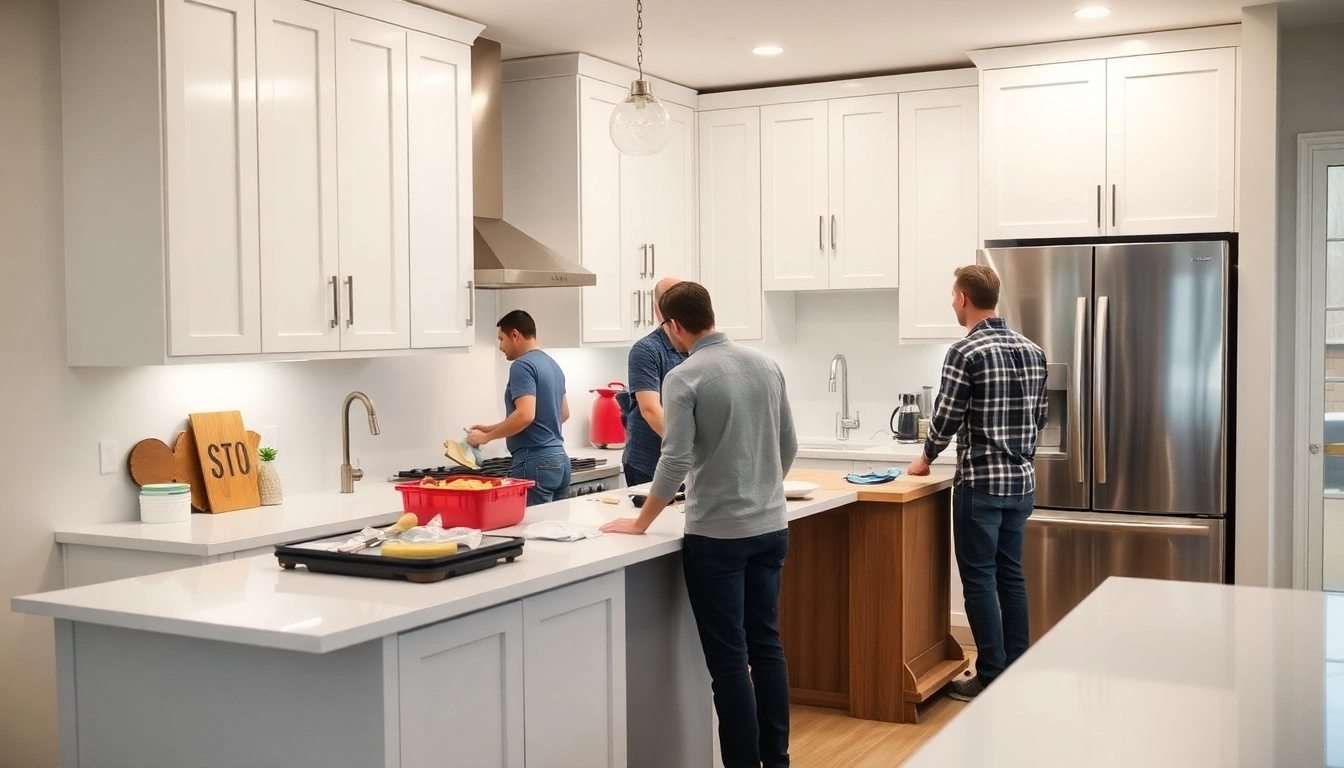Understanding Remodeling: Principles and Definitions
Remodeling has become a pivotal aspect of homeownership and property management, serving as a strategic approach to enhancing the functionality, aesthetic appeal, and value of residential and commercial spaces. Whether driven by changing lifestyle needs, aging infrastructure, or the pursuit of modern design trends, remodeling projects require a comprehensive understanding of their scope, processes, and best practices. In this in-depth guide, we will explore the essential facets of remodeling—from its fundamental definition to innovative trends—equipping homeowners, investors, and industry professionals with the knowledge needed to execute successful projects.
What Does Remodeling Entail?
At its core, remodeling involves modifying or updating a property’s structure, layout, or appearance to better suit current needs or aesthetic preferences. The Remodeling process can range from minor cosmetic updates—such as painting or replacing fixtures—to extensive overhauls that reconfigure fundamental aspects of the building’s architecture. Popular remodeling endeavors include kitchen and bathroom upgrades, basement conversions, room additions, and whole-house renovations.
Essentially, remodeling aims to improve the usability, safety, and overall value of the property by implementing targeted changes aligned with the owner’s vision and goal. It often involves careful planning, selection of appropriate materials, and coordination with skilled contractors and designers to ensure that the transformations meet high standards of quality and durability.
Difference Between Remodeling and Renovating
Many homeowners and professionals frequently encounter the terms remodeling and renovating, often using them interchangeably. However, understanding the nuanced differences is critical for setting realistic expectations and planning effectively.
Renovating
Renovating primarily involves cosmetic improvements designed to refresh or update a space without altering its fundamental structure. Typical renovation activities include repainting walls, installing new flooring, replacing fixtures, and updating cabinetry. These changes enhance visual appeal and can increase a property’s marketability without major structural work.
Remodeling
In contrast, remodeling entails transforming the physical layout or structural components of a space. This could involve tearing down walls to create open-concept layouts, reconfiguring room sizes, or upgrading foundational elements like electrical and plumbing systems. Remodeling projects are generally more complex, expensive, and time-consuming, but they offer greater flexibility and impact in terms of property enhancement.
Both processes can significantly impact a home’s value, but remodeling is often chosen when a dramatic change or overhaul is desired, while renovating is suited for minor updates that reinforce a space’s current function.
Common Types of Remodeling Projects
The scope of remodeling varies widely depending on the owner’s goals, budget, and property type. Below are some prevalent categories:
- Kitchen Remodeling: One of the most popular projects, focusing on cabinets, countertops, appliances, lighting, and layout reconfiguration to increase functionality and modern aesthetics.
- Bathroom Remodeling: Updating fixtures, tiles, vanities, and lighting for better comfort and style, often including plumbing upgrades and accessibility features.
- Basement Finishing: Converting an unfinished basement into livable space such as a family room, entertainment area, or additional bedrooms.
- Room Additions: Extending living spaces by building new rooms or expanding existing ones, often to accommodate growing families or create dedicated home offices.
- Whole-House Renovation: Comprehensive overhaul of a home’s interior and exterior to modern standards, combining multiple smaller projects into a cohesive redesign.
Each type involves specific planning, skill sets, and materials selection, emphasizing the importance of strategic project management.
Planning Your Remodeling Project
Successful remodeling hinges on meticulous planning and clear goal-setting. Developing a comprehensive plan helps avoid costly delays, budget overruns, and design mismatches.
Setting Realistic Goals and Budgeting
Before initiating a project, define your objectives—are you seeking increased comfort, improved aesthetics, better energy efficiency, or higher property value? Once goals are clear, establish a realistic budget by researching average costs for your desired upgrades and accounting for contingencies.
For example, kitchen remodels in the U.S. can cost anywhere from $10,000 to over $50,000 depending on scale and quality of materials. A detailed budget estimate should include all expenses: permitting, materials, labor, and unforeseen repairs. Proper budgeting ensures you prioritize essential features and make informed trade-offs.
Design Inspiration and Selecting Styles
Design inspiration can be sourced from home magazines, online portfolios, social media, and showrooms. It’s crucial to align your aesthetic preferences with current trends and your home’s architectural style. Whether you favor modern minimalism, rustic charm, or classic elegance, selecting a cohesive style helps guide material choices, color palettes, and layout arrangements.
Engaging a professional designer or using digital visualization tools can assist in translating ideas into actionable plans, ensuring your vision is achievable and aligned with your budget.
Choosing the Right Contracting Team
Selecting a reliable contractor is fundamental. Key factors include experience, portfolio, client testimonials, licensing, insurance, and clear communication. Local remodeling experts, such as those found among the top Rochester contractors, understand regional codes and availability of quality materials. Conduct interviews, verify references, and request detailed bids to compare offers fairly.
Involving reputable specialists early on ensures quality craftsmanship and adherence to timeline and budget expectations, ultimately securing project success.
Executing a Successful Remodeling Process
With plans in place, the next phase involves executing the project through well-organized steps that prioritize safety, quality, and efficiency.
Steps from Permitting to Construction
Starting with permits, ensure compliance with local building codes and regulations. This often involves submitting plans for approval and securing necessary documents. Once permits are obtained, demolition (if needed) and site prep commence, followed by framing, mechanical installations, finishes, and inspections at various stages.
Project managers should coordinate schedules, materials deliveries, and subcontractors seamlessly to maintain smooth workflow. Regular site visits and communication with the contractor help identify issues early and keep the project on track.
Managing Project Timelines and Expectations
Establish realistic timelines by considering project complexity and seasonal factors. Use milestone checklists to track progress and address delays proactively. Transparent communication with all stakeholders minimizes misunderstandings and manages expectations effectively.
Quality Control and Problem-solving Strategies
Regular inspections, detailed punch lists, and adherence to standards are essential for quality assurance. During construction, unforeseen issues—like hidden wiring or structural defects—may arise. Employing a proactive problem-solving approach, backed by experienced supervision, ensures these challenges are resolved promptly without compromising the overall project.
Measuring Remodeling Success and ROI
Post-project evaluation involves assessing both subjective and objective outcomes to determine if initial goals are met and whether the investment has paid off.
Assessing Project Outcomes and Satisfaction
Gather feedback from homeowners or tenants regarding functionality, aesthetic appeal, and comfort. Photographic documentation and before-and-after comparisons are valuable for visual evaluation. Address any lingering issues or deficiencies quickly to maintain satisfaction.
Cost vs. Value: Making Smart Investment Decisions
Understanding the return on investment (ROI) is vital. Kitchen remodels, for example, often recoup 60-80% of costs in increased home value. Focus on high-impact, durable upgrades that appeal to future buyers—like energy-efficient windows, quality appliances, and modern fixtures.
Consult real estate market data and appraisals to inform your decisions, ensuring that your remodeling aligns with neighborhood standards and buyer expectations.
Maintenance Tips for Long-lasting Results
Long-term success requires proactive upkeep. Regular cleaning, addressing minor repairs promptly, and applying protective finishes extend the life of your remodel. For instance, sealing grout in bathrooms prevents water damage, while routine HVAC maintenance preserves system efficiency.
Innovative Trends in Remodeling
The remodeling industry continually evolves, driven by technological advances, sustainability goals, and changing lifestyles. Staying informed about trends enables homeowners to incorporate innovative features that add value and functionality.
Sustainable and Eco-Friendly Materials
Green building materials, such as reclaimed wood, bamboo flooring, low-VOC paints, and recycled metal fixtures, reduce environmental impact and improve indoor air quality. Incorporating energy-efficient insulation, windows, and appliances further decreases utility costs and carbon footprint.
Research-backed sustainable choices not only support environmental goals but often qualify for tax incentives and grants, making them financially advantageous.
Smart Home Integration and Technology
Home automation systems—covering lighting, security, climate control, and entertainment—are transforming the way we live. Integrating smart devices during remodels simplifies control, enhances security, and improves energy efficiency. For example, programmable thermostats and smart lighting reduce energy costs significantly over time.
Embedding wiring infrastructure for future upgrades ensures your home remains technologically versatile and future-proofed.
Designing for Accessibility and Future Needs
Creating inclusive living spaces involves universal design principles—wider doorways, zero-threshold entries, lever-style handles, and accessible bathrooms. Such features ensure the home caters to aging residents, individuals with disabilities, or future resale value.
Future-proofing involves planning adaptable layouts and infrastructure that can evolve with changing needs.







